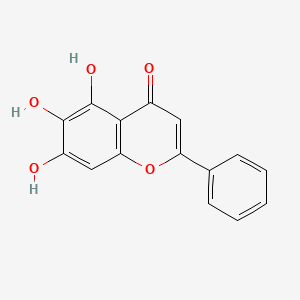Drug Information
Drug (ID: DG00010) and It's Reported Resistant Information
| Name |
Baicalein
|
||||
|---|---|---|---|---|---|
| Synonyms |
Baicalein; 491-67-8; 5,6,7-Trihydroxyflavone; 5,6,7-trihydroxy-2-phenyl-4H-chromen-4-one; Noroxylin; Biacalein; BaiKalein; Baicelein; UNII-49QAH60606; NSC661431; NSC 661431; CHEMBL8260; 5,6,7-trihydroxy-2-phenylchromen-4-one; CHEBI:2979; FXNFHKRTJBSTCS-UHFFFAOYSA-N; MFCD00017459; 4H-1-Benzopyran-4-one, 5,6,7-trihydroxy-2-phenyl-; 49QAH60606; 5,7-Trihydroxyflavone; 5,6,7-trihydroxy-2-phenyl-chromen-4-one; Sho-saiko-to; SMR000112462; SR-01000597499; Baicalein, 8; Baicalein,(S); 3WL; Baicalein, 14; Baicalein, 98%; AC1NQYPP; Tocris-1761
Click to Show/Hide
|
||||
| Indication |
In total 1 Indication(s)
|
||||
| Structure |

|
||||
| Target | Arachidonate 5-lipoxygenase (5-LOX) | LOX5_HUMAN | [1] | ||
| L-selectin (SELL) | LYAM1_HUMAN | [1] | |||
| Lactoylglutathione lyase (GLO1) | LGUL_HUMAN | [1] | |||
| P-selectin (SELP) | LYAM3_HUMAN | [1] | |||
| Prolyl endopeptidase (PREP) | PPCE_HUMAN | [1] | |||
| Tumor necrosis factor (TNF) | TNFA_HUMAN | [1] | |||
| Xanthine dehydrogenase/oxidase (XDH) | XDH_HUMAN | [1] | |||
| Click to Show/Hide the Molecular Information and External Link(s) of This Drug | |||||
| Formula |
C15H10O5
|
||||
| IsoSMILES |
C1=CC=C(C=C1)C2=CC(=O)C3=C(O2)C=C(C(=C3O)O)O
|
||||
| InChI |
1S/C15H10O5/c16-9-6-11(8-4-2-1-3-5-8)20-12-7-10(17)14(18)15(19)13(9)12/h1-7,17-19H
|
||||
| InChIKey |
FXNFHKRTJBSTCS-UHFFFAOYSA-N
|
||||
| PubChem CID | |||||
| ChEBI ID | |||||
| TTD Drug ID | |||||
| DrugBank ID | |||||
Type(s) of Resistant Mechanism of This Drug
Drug Resistance Data Categorized by Their Corresponding Diseases
ICD-02: Benign/in-situ/malignant neoplasm
| Drug Sensitivity Data Categorized by Their Corresponding Mechanisms | ||||
|
|
||||
| Key Molecule: NF-kappaB interacting LncRNA (NKILA) | [2] | |||
| Molecule Alteration | Expression | Up-regulation |
||
| Sensitive Disease | Hepatocellular carcinoma [ICD-11: 2C12.2] | |||
| Experimental Note | Revealed Based on the Cell Line Data | |||
| Cell Pathway Regulation | Cell apoptosis | Activation | hsa04210 | |
| Cell invasion | Inhibition | hsa05200 | ||
| Cell viability | Inhibition | hsa05200 | ||
| NF-kappaB signaling pathway | Inhibition | hsa04064 | ||
| In Vitro Model | HepG2 cells | Liver | Homo sapiens (Human) | CVCL_0027 |
| HCCLM3 cells | Liver | Homo sapiens (Human) | CVCL_6832 | |
| Hep3B cells | Liver | Homo sapiens (Human) | CVCL_0326 | |
| SMMC7721 cells | Uterus | Homo sapiens (Human) | CVCL_0534 | |
| QSG-7701 cells | Liver | Homo sapiens (Human) | CVCL_6944 | |
| In Vivo Model | Nude mouse xenograft model | Mus musculus | ||
| Experiment for Molecule Alteration |
qRT-PCR | |||
| Experiment for Drug Resistance |
Luminescent cell viability assay; TUNEL assay; Transwell assay | |||
| Mechanism Description | NkILA inhibited IkBalpha phosphorylation and enhanced the inhibitory roles of baicalein on NF-kB signaling in HCC cells. | |||
|
|
||||
| Key Molecule: NF-kappa-B inhibitor alpha (NFKBIA) | [2] | |||
| Molecule Alteration | Phosphorylation | Down-regulation |
||
| Sensitive Disease | Hepatocellular carcinoma [ICD-11: 2C12.2] | |||
| Experimental Note | Revealed Based on the Cell Line Data | |||
| Cell Pathway Regulation | Cell apoptosis | Activation | hsa04210 | |
| Cell invasion | Inhibition | hsa05200 | ||
| Cell viability | Inhibition | hsa05200 | ||
| NF-kappaB signaling pathway | Inhibition | hsa04064 | ||
| In Vitro Model | HepG2 cells | Liver | Homo sapiens (Human) | CVCL_0027 |
| HCCLM3 cells | Liver | Homo sapiens (Human) | CVCL_6832 | |
| Hep3B cells | Liver | Homo sapiens (Human) | CVCL_0326 | |
| SMMC7721 cells | Uterus | Homo sapiens (Human) | CVCL_0534 | |
| QSG-7701 cells | Liver | Homo sapiens (Human) | CVCL_6944 | |
| In Vivo Model | Nude mouse xenograft model | Mus musculus | ||
| Experiment for Molecule Alteration |
Western blot analysis | |||
| Experiment for Drug Resistance |
Luminescent cell viability assay; TUNEL assay; Transwell assay | |||
| Mechanism Description | NkILA inhibited IkBalpha phosphorylation and enhanced the inhibitory roles of baicalein on NF-kB signaling in HCC cells. | |||
| Drug Sensitivity Data Categorized by Their Corresponding Mechanisms | ||||
|
|
||||
| Key Molecule: Long non-protein coding RNA (BDLNR) | [1] | |||
| Molecule Alteration | Expression | Up-regulation |
||
| Sensitive Disease | Cervical cancer [ICD-11: 2C77.0] | |||
| Experimental Note | Revealed Based on the Cell Line Data | |||
| Cell Pathway Regulation | PI3K/AKT signaling pathway | Inhibition | hsa04151 | |
| In Vitro Model | Hela cells | Cervix uteri | Homo sapiens (Human) | CVCL_0030 |
| Siha cells | Cervix uteri | Homo sapiens (Human) | CVCL_0032 | |
| Caski cells | Uterus | Homo sapiens (Human) | CVCL_1100 | |
| ME-180 cells | Uterus | Homo sapiens (Human) | CVCL_1401 | |
| Experiment for Molecule Alteration |
qRT-PCR | |||
| Experiment for Drug Resistance |
Glo cell viability assays | |||
| Mechanism Description | Baicalein inhibits cervical cancer progression via downregulating long noncoding RNA BDLNR and its downstream PI3 k/Akt pathway. BDLNR physically bound to YBX1, recruited YBX1 to PIk3CA promoter, activated PIk3CA expression and PI3 k/Akt pathway. | |||
References
If you find any error in data or bug in web service, please kindly report it to Dr. Sun and Dr. Zhang.
